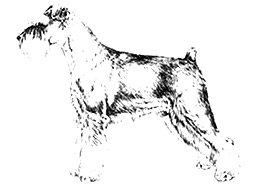Schnauzer
Last updated: 22 May 2009
A breed standard is the guideline which describes the ideal characteristics, temperament, and appearance of a breed and ensures that the breed is fit for function with soundness essential. Breeders and judges should at all times be mindful of features which could be detrimental in any way to the health, welfare or soundness of this breed.

Kennel Club, London 1994
-
Group:
Group 6 (Utility)
-
History:
-
General Appearance:
Sturdily built, robust, sinewy, nearly square, (length of body equal to height at shoulders). Expression keen and attitude alert. Correct conformation is of more importance than colour or purely 'beauty' points.
-
Characteristics:
Strong, vigorous dog capable of great endurance.
-
Temperament:
Alert, reliable and intelligent. Primarily a companion dog.
-
Head And Skull:
Head strong and of good length, narrowing from ears to eyes and then gradually forward toward end of nose. Upper part of the head (occiput to the base of the forehead) moderately broad between ears. Flat, creaseless forehead; well muscled but not too strongly developed cheeks. Medium stop to accentuate prominent eyebrows. Powerful muzzle ending in a moderately blunt line, with bristly, stubby moustache and chin whiskers. Ridge of nose straight and running almost parallel to extension of forehead. Nose black with wide nostrils. Lips tight but not overlapping.
-
Eyes:
Medium sized, dark, oval, set forward, with arched bushy eyebrows.
-
Ears:
Neat, V-shaped, set high and dropping forward to temple.
-
Mouth:
Jaws strong, with a perfect, regular and complete scissor bite, i.e. the upper teeth closely overlapping the lower teeth and set square to the jaws.
-
Neck:
Moderately long, strong, and slightly arched; skin close to throat; neck set cleanly on shoulders.
-
Forequarters:
Shoulders flat and well laid. Forelegs straight viewed from any angle. Muscles smooth and lithe rather than prominent; bone strong, straight and carried well down to feet; elbows close to body and pointing directly backward.
-
Body:
Chest moderately broad; deep with visible, strong breastbone reaching at least to height of elbow and rising slightly backward to loins. Back strong and straight, slightly higher at shoulder than at hindquarters, with short well developed loins. Ribs well sprung. Length of body equal to height from top of withers to ground.
-
Hindquarters:
Thighs slanting and flat but strongly muscled. Hindlegs (upper and lower thighs) at first vertical to the stifle; from stifle to hock in line with the extension of the upper neck line; from hock, vertical to ground.
-
Feet:
Short, round, cat-like, compact with closely arched toes, dark nails, firm black pads, feet pointing forward.
-
Tail:
Docked: Set on and carried high, customarily docked to three [3] joints.
Undocked: Set on and carried high, of moderate length to give general balance to the dog. Thick at root and tapering towards the tip, as straight as possible, carried jauntily.
-
Gait/Movement:
Free, balanced and vigorous, with good reach in forequarters and good driving power in hindquarters. Topline remains level in action.
-
Coat:
Harsh, wiry and short enough for smartness. Closer on neck and shoulders; clean on throat, skull and ears. Harsh hair on legs. Dense undercoat essential.
-
Colour:
Pure black, (white markings on head, chest and legs undesirable) or pepper and salt. Pepper and salt shades range from dark iron grey to light grey; good pigmentation. Hairs banded dark/light/dark. Facial mask to harmonise with corresponding coat colour.
-
Sizes:
Ideal height:
Dogs 48 cms (19 ins) at withers
Bitches 46 cms (18 ins) at withers
Any variations of more than 2.5 cms (1 inch) in these heights undesirable.
-
Faults:
Any departure from the foregoing points should be considered a fault and the seriousness with which the fault should be regarded should be in exact proportion to its degree and its effect upon the health and welfare of the dog.
-
Notes:
Male animals should have two apparently normal testicles fully descended into the scrotum.
 For owners
For owners
 Members
Members
 Dogs Australia is a not-for-profit organisation advocating for the preservation of purebred dogs through ethical breeding.
It champions the highest standard of animal welfare through education and fostering dog-loving communities.
Internationally recognised and established in 1958 as the Australian National Kennel Council (ANKC),
the organisation promotes responsible dog ownership; maintains the ORCHID* heritable canine diseases database;
funds research into canine diseases; and supports state and territory-based member bodies.
Dogs Australia promotes breed conformation shows and community sports for dogs that fulfil a breed’s natural instincts.
Dogs Australia is a not-for-profit organisation advocating for the preservation of purebred dogs through ethical breeding.
It champions the highest standard of animal welfare through education and fostering dog-loving communities.
Internationally recognised and established in 1958 as the Australian National Kennel Council (ANKC),
the organisation promotes responsible dog ownership; maintains the ORCHID* heritable canine diseases database;
funds research into canine diseases; and supports state and territory-based member bodies.
Dogs Australia promotes breed conformation shows and community sports for dogs that fulfil a breed’s natural instincts.







